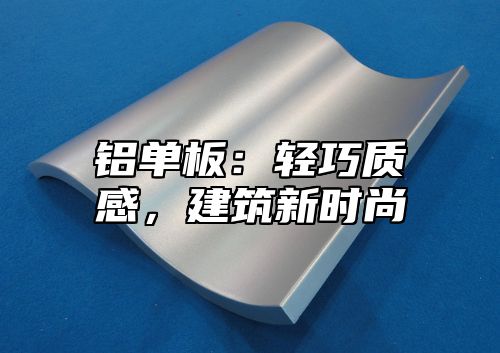

 Industry information
Industry information
Dear architecture enthusiasts, today let's talk about a cool material - aluminum veneer. You may think that this is just an aluminum plate, what's there to say? But don't underestimate this thing, it is the new darling of modern architecture, not only adding a lot of color to buildings, but also bringing a lot of convenience to our lives.
Let's talk about the lightness of aluminum veneer. We all know that aluminum itself is a relatively light metal, and aluminum veneer is made by processing aluminum into sheet metal, which naturally has a lighter weight. I remember once passing by a newly built building that used aluminum veneer as its exterior wall material. From a distance, it looked like a thin layer of metal film covering the building, giving people a feeling of lightness. Think about it, using such lightweight materials can also reduce the burden on the building itself, and transportation and installation are naturally much more convenient.
Let's talk about the texture of aluminum veneer again. The surface of aluminum veneer can be processed into various textures and colors, from simple metallic luster to retro wood grain, to fashionable stone texture, all of which can meet the needs of different architectural styles. I personally prefer aluminum veneers with a metallic sheen, as they have a modern feel while maintaining stability.
Aluminum veneer also has good weather resistance. It is not afraid of wind and rain, and is not easy to rust, with a long service life. In this way, not only does it save maintenance trouble, but it also saves a lot of costs for the building.
Let's talk about the environmental friendliness of aluminum veneer. Aluminum is a recyclable material, and aluminum veneers are produced to minimize environmental pollution. Using aluminum veneer as a building material not only embodies the concept of green environmental protection, but also contributes to our planet.
What are the specific applications of aluminum veneer? Its most common application is exterior wall decoration. Many commercial buildings, office buildings, and even residential communities use aluminum veneers to enhance the overall aesthetics of the building. Aluminum veneer can also be used for interior decoration, such as ceilings, walls, and even stair handrails.
Aluminum veneer also has its limitations. It is relatively easy to scratch, so it is necessary to pay attention to maintenance during use. Due to the thinness of aluminum veneer, it may not be suitable in some situations where high strength is required.
Here, I want to tell you a little story. I remember once I was a guest at a friend's house, and their new house was decorated with aluminum veneer. The house is decorated very stylishly, especially the living room ceiling, which uses a type of aluminum veneer with metallic luster, which is eye-catching. When I asked him why he chose aluminum veneer, he told me that on the one hand, he valued its beauty and weather resistance, and on the other hand, he pursued a modern architectural style.
This story reminds me of when I was renovating my new house, I also considered using aluminum veneer. At that time, I searched for a lot of information online and found that aluminum veneer does have many advantages. However, in the final decision, I still chose other materials. Because I believe that every material has its own characteristics, and we need to choose according to our own needs.
I want to say that aluminum veneer, as a modern building material, has indeed brought us a lot of convenience. But when choosing materials, we also need to consider various factors comprehensively, such as price, aesthetics, practicality, etc. Only in this way can we make our buildings both beautiful and practical.
Aluminum veneer is a good building material that is lightweight, high-quality, environmentally friendly, and durable. If you are renovating a new house or designing a building, you may want to consider this material. Maybe it will bring you unexpected surprises!